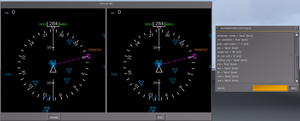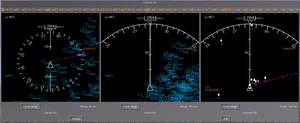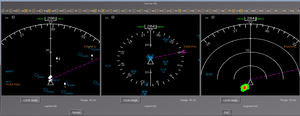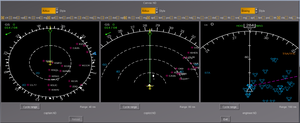Howto:Prototyping a new NavDisplay Style
| This article is a stub. You can help the wiki by expanding it. |
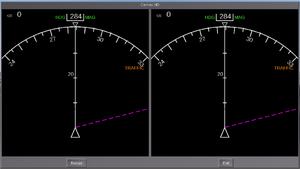
Objective
Demonstrate how a simple PUI/XML dialog can be used to easily prototype new NavDisplay styles, showing two instances for each pilot, which can be controlled/tested independently (using different settings for range, modes, traffic etc). Once the dialog is closed/reopened, the underlying navdisplay.mfd/styles files are also automatically reloaded from disk, so that you don't need to exist/restart fgfs to test your cchanges.
Approach
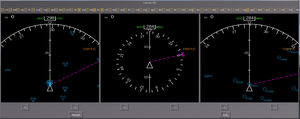
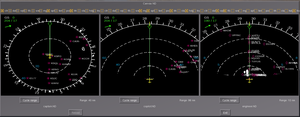
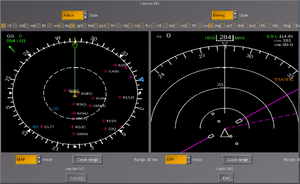
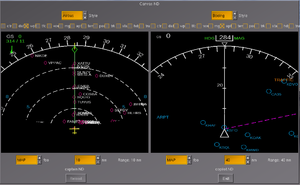
This is a PUI/XML dialog with two embedded CanvasWidget areas that instantiate independent ND instances using a subset of the code commonly found in the aircraft specific ND.nas file, adapted to use the embedded Canvas region for rendering the two NDs and GUI buttons/widgets added to control the whole thing without necessarily requiring a fully developed cockpit.
This is primarily useful for rapid prototyping ("RAD"), i.e. quickly testing additions and changes without having to exit/restart fgfs and without having a full aircraft developed yet.
Goals
Primarily, this dialog is intended to help with:
- regression testing
- refactoring of the ND/PFD code
- decoupling of styling related stuff and aircraft specific code (hard-coded assumptions)
- integration with Richard's MFD framework
- testing of independent instances
- benchmarking/profiling and stress-testing the ND/Canvas code respectively
- hardening the code
Roadmap
- add buttons for controlling each ND instance (range, zoom, centering)

- use io.include to directly reload the styles stuff (for rapid prototyping) (this will require changes to navdisplay.mfd which should be reviewed/tested by Gijs and Hyde)

- procedurally add buttons for each switch by enhancing the myCockpit_switches hash with legends/labels for the UI use-case (use checkboxes for boolean props)
 Done
Done - add a dropdown menu to select the position source (main aircraft vs. AI/MP traffic)
- maybe allow the style to be selected/changed at runtime, possibly per ND ?

- add VSD support
Issues
- Currently, the code will re-instantiate a new NavDisplay when the style is changed - however, it makes more sense to simply set a corresponding property and close/reopen the dialog, as that would then also allow us to procedurally add style-specific GUI widgets (the Airbus style supports a handful of features that the Boeing one does not know anything about), besides this would make the whole reload button obsolete, too.
 Not done
Not done
Status
For now this is heavily based on ideas, and code, borrowed from the original MapStructure Debugger (code still available at [1])
The canvas widget is procedurally added to the dialog using the techniques discussed at Aircraft_Generation_Wizard#Under_the_Hood.
Base Package changes
Note The following patch contains changes that mainly take care of two things:
As of 10/2016, these should be included of the base package, i.e. available in 2016.4 [1]) |
diff --git a/Nasal/canvas/api.nas b/Nasal/canvas/api.nas
index ea67217..8fd77e5 100644
--- a/Nasal/canvas/api.nas
+++ b/Nasal/canvas/api.nas
@@ -462,7 +462,7 @@ var Map = {
},
del: func()
{
- #print("canvas.Map.del()");
+ # print("canvas.Map.del()");
if (me.controller != nil)
me.controller.del(me);
foreach (var k; keys(me.layers)) {
diff --git a/Nasal/canvas/map/navdisplay.mfd b/Nasal/canvas/map/navdisplay.mfd
index d2d2ef5..f811f16 100644
--- a/Nasal/canvas/map/navdisplay.mfd
+++ b/Nasal/canvas/map/navdisplay.mfd
@@ -106,6 +106,7 @@ var NavDisplay = {
removelistener(l);
# clean up MapStructure
me.map.del();
+ # call(canvas.Map.del, [], me.map);
# destroy the canvas
if (me.canvas_handle != nil)
me.canvas_handle.del();
@@ -253,7 +254,7 @@ var NavDisplay = {
me.df_options = nil;
if (contains(me.nd_style, 'options'))
me.df_options = me.nd_style.options;
- nd_options = default_hash(nd_options, me.df_options);
+ nd_options = canvas.default_hash(nd_options, me.df_options);
me.options = nd_options;
me.route_driver = nil;
if (me.options == nil) me.options = {};
@@ -275,22 +276,9 @@ var NavDisplay = {
if(contains(feature.impl,'init')) feature.impl.init(me.nd, feature); # call The element's init code (i.e. updateCenter)
}
- ### this is the "old" method that's less flexible, we want to use the style hash instead (see above)
- # because things are much better configurable that way
- # now look up all required SVG elements and initialize member fields using the same name to have a convenient handle
- foreach(var element; ["dmeLDist","dmeRDist","dmeL","dmeR","vorL","vorR","vorLId","vorRId",
- "status.wxr","status.wpt","status.sta","status.arpt"])
- me.symbols[element] = me.nd.getElementById(element);
+ me.nd_style.initialize_elements(me);
- # load elements from vector image, and create instance variables using identical names, and call updateCenter() on each
- # anything that needs updatecenter called, should be added to the vector here
- #
- foreach(var element; ["staArrowL2","staArrowR2","staFromL2","staToL2","staFromR2","staToR2",
- "hdgTrk","trkInd","hdgBug","HdgBugCRT","TrkBugLCD","HdgBugLCD","curHdgPtr",
- "HdgBugCRT2","TrkBugLCD2","HdgBugLCD2","hdgBug2","selHdgLine","selHdgLine2","curHdgPtr2",
- "staArrowL","staArrowR","staToL","staFromL","staToR","staFromR"] )
- me.symbols[element] = me.nd.getElementById(element).updateCenter();
-
+
var map_rect = [124, 1024, 1024, 0];
var map_opts = me.options['map'];
if (map_opts == nil) map_opts = {};
@@ -342,6 +330,7 @@ var NavDisplay = {
get_tuned_course:get_course_by_freq,
get_position: get_current_position,
new: func(map) return { parents:[controller], map:map },
+ del: func() {print("cleaning up nd controller");},
should_update_all: func {
# TODO: this is just copied from aircraftpos.controller,
# it really should be moved to somewhere common and reused
@@ -386,12 +375,12 @@ var NavDisplay = {
if(!layer['isMapStructure']) # set up an old INEFFICIENT and SLOW layer
the_layer = me.layers[layer.name] = canvas.MAP_LAYERS[layer.name].new( me.map, layer.name, controller );
else {
- printlog(_MP_dbg_lvl, "Setting up MapStructure-based layer for ND, name:", layer.name);
+ printlog(canvas._MP_dbg_lvl, "Setting up MapStructure-based layer for ND, name:", layer.name);
var opt = me.options != nil and me.options[layer.name] != nil ? me.options[layer.name] : nil;
if (opt == nil and contains(layer, 'options'))
opt = layer.options;
if (opt != nil and default_opts != nil)
- opt = default_hash(opt, default_opts);
+ opt = canvas.default_hash(opt, default_opts);
#elsif(default_opts != nil)
# opt = default_opts;
var style = nil;
@@ -420,7 +409,7 @@ var NavDisplay = {
l.predicate = func {
var t = systime();
call(_predicate, arg, me);
- printlog(_MP_dbg_lvl, "Took "~((systime()-t)*1000)~"ms to update layer "~l.name);
+ printlog(canvas._MP_dbg_lvl, "Took "~((systime()-t)*1000)~"ms to update layer "~l.name);
}
})();
}
@@ -805,7 +794,7 @@ var NavDisplay = {
me.symbols['status.arpt'].setVisible( me.get_switch('toggle_airports') and me.in_mode('toggle_display_mode', ['MAP']));
me.symbols['status.sta'].setVisible( me.get_switch('toggle_stations') and me.in_mode('toggle_display_mode', ['MAP']));
# Okay, _how_ do we hook this up with FGPlot?
- printlog(_MP_dbg_lvl, "Total ND update took "~((systime()-_time)*100)~"ms");
+ printlog(canvas._MP_dbg_lvl, "Total ND update took "~((systime()-_time)*100)~"ms");
setprop("/instrumentation/navdisplay["~ NavDisplay.id ~"]/update-ms", systime() - _time);
} # of update() method (50% of our file ...seriously?)
};
diff --git a/Nasal/canvas/map/navdisplay.styles b/Nasal/canvas/map/navdisplay.styles
index 7712727..52751a2 100644
--- a/Nasal/canvas/map/navdisplay.styles
+++ b/Nasal/canvas/map/navdisplay.styles
@@ -34,6 +34,27 @@ var NDStyles = {
# aircraft developers should all be editing the same ND.svg image
# the code can deal with the differences now
svg_filename: "Nasal/canvas/map/Images/boeingND.svg",
+
+ initialize_elements: func(me) {
+
+ ### this is the "old" method that's less flexible, we want to use the style hash instead (see above)
+ # because things are much better configurable that way
+ # now look up all required SVG elements and initialize member fields using the same name to have a convenient handle
+ foreach(var element; ["dmeLDist","dmeRDist","dmeL","dmeR","vorL","vorR","vorLId","vorRId",
+ "status.wxr","status.wpt","status.sta","status.arpt"])
+ me.symbols[element] = me.nd.getElementById(element);
+
+ # load elements from vector image, and create instance variables using identical names, and call updateCenter() on each
+ # anything that needs updatecenter called, should be added to the vector here
+ #
+ foreach(var element; ["staArrowL2","staArrowR2","staFromL2","staToL2","staFromR2","staToR2",
+ "hdgTrk","trkInd","hdgBug","HdgBugCRT","TrkBugLCD","HdgBugLCD","curHdgPtr",
+ "HdgBugCRT2","TrkBugLCD2","HdgBugLCD2","hdgBug2","selHdgLine","selHdgLine2","curHdgPtr2",
+ "staArrowL","staArrowR","staToL","staFromL","staToR","staFromR"] )
+ me.symbols[element] = me.nd.getElementById(element).updateCenter();
+
+ }, # initialize_elements
+
##
## this loads and configures existing layers (currently, *.layer files in Nasal/canvas/map)
##
@@ -1132,6 +1153,29 @@ var NDStyles = {
# aircraft developers should all be editing the same ND.svg image
# the code can deal with the differences now
svg_filename: "Nasal/canvas/map/Airbus/Images/airbusND.svg",
+
+ initialize_elements: func(me) {
+
+ ### this is the "old" method that's less flexible, we want to use the style hash instead (see above)
+ # because things are much better configurable that way
+ # now look up all required SVG elements and initialize member fields using the same name to have a convenient handle
+ foreach(var element; ["dmeLDist","dmeRDist","dmeL","dmeR","vorL","vorR","vorLId","vorRId",
+ "status.wxr","status.wpt","status.sta","status.arpt"])
+ me.symbols[element] = me.nd.getElementById(element);
+
+ # load elements from vector image, and create instance variables using identical names, and call updateCenter() on each
+ # anything that needs updatecenter called, should be added to the vector here
+ #
+ foreach(var element; ["staArrowL2","staArrowR2","staFromL2","staToL2","staFromR2","staToR2",
+ "hdgTrk","trkInd","hdgBug","HdgBugCRT","TrkBugLCD","HdgBugLCD","curHdgPtr",
+ "HdgBugCRT2","TrkBugLCD2","HdgBugLCD2","hdgBug2","selHdgLine","selHdgLine2","curHdgPtr2",
+ "staArrowL","staArrowR","staToL","staFromL","staToR","staFromR"] )
+ me.symbols[element] = me.nd.getElementById(element).updateCenter();
+
+ }, # initialize_elements
+
+
+
##
## this loads and configures existing layers (currently, *.layer files in Nasal/canvas/map)
##
Code
Note For testing purposes, put the following dialog into $FG_ROOT/gui/dialogs/canvas-nd.xml and use the Nasal Console to run the dialog (or extend the Menubar accordingly):
fgcommand('dialog-show', props.Node.new({'dialog-name':'canvas-nd'}) ); |
<?xml version="1.0"?><?xml version="1.0"?>
<PropertyList>
<name>canvas-nd</name>
<modal>false</modal>
<layout>vbox</layout>
<text>
<label>Canvas ND</label>
</text>
<widget-templates>
<nd-checkbox>
<name>checkbox-template</name>
<checkbox>
<pref-width>30</pref-width>
<pref-height>22</pref-height>
<label>nd-checkbox</label>
<halign>left</halign>
<property></property>
<live>true</live>
<binding>
<command>dialog-apply</command>
</binding>
<!--
<binding>
<command>property-toggle</command>
<property>this will be customized</property>
</binding>
-->
</checkbox>
</nd-checkbox>
<canvas-widget>
<name>canvas-mfd</name>
<group>
<layout>vbox</layout>
<group>
<layout>hbox</layout>
<name>mfd-controls</name>
</group>
<canvas>
<name></name>
<valign>fill</valign>
<halign>fill</halign>
<stretch>true</stretch>
<pref-width>400</pref-width>
<pref-height>400</pref-height>
<view>1024</view>
<view>1024</view>
<nasal>
<load>
</load>
</nasal>
</canvas>
<!-- ND/Canvas specific controls placed at the bottom of the display (e.g. range) -->
<group>
<layout>hbox</layout>
<button>
<legend>Cycle range</legend>
<equal>true</equal>
<binding>
<command>property-cycle</command>
<property>WILL BE FILLED IN PROCEDURALLY</property>
<!-- TODO populate from values vector-->
<value>10</value>
<value>20</value>
<value>40</value>
<value>80</value>
<value>160</value>
<value>320</value>
</binding>
</button>
<text>
<format>Range: %s nm</format>
<property>WILL BE FILLED IN PROCEDURALLY</property>
<live>true</live>
</text>
</group>
</group>
</canvas-widget>
</widget-templates>
<nasal>
<open><![CDATA[
# print("Nasal/open");
var getWidgetTemplate = func(identifier) {
var target = globals.gui.findElementByName(root, identifier );
if(target == nil) die("Target node not found for type:"~identifier);
return target;
}
###
# locate required templates
var target = getWidgetTemplate(root:cmdarg(), identifier:'canvas-placeholder');
var template = getWidgetTemplate(root:cmdarg(), identifier:'canvas-mfd');
var checkboxTemplate = getWidgetTemplate(root:cmdarg(), identifier:'checkbox-template');
var initialize_nd = func(index) {
var my_canvas = canvas.get( cmdarg() ); # this will get a handle to the parent canvas:
# show_canvas_id(my_canvas); # this is for debugging only
setupND(mfd_root: "/instrumentation/efis["~index~"]", my_canvas: my_canvas);
};
var errors = [];
# NOTE: this requires changes to navdisplay.mfd
# call(func[, args[, me[, locals[, error]]]);
# call(
io.include('Nasal/canvas/map/navdisplay.mfd');
#, nil, closure(initialize_nd), var errors=[]);
if (size(errors)) {
canvas.MessageBox.critical(
"$FG_ROOT/Nasal/canvas/map/navdisplay.mfd",
"Error reloading navdisplay.mfd and/or navdisplay.styles:\n",
cb = nil,
buttons = canvas.MessageBox.Ok
);
# TODO: close dialog on error
}
# debug.dump( NDStyles );
print("ND Styles found:", size(keys(NDStyles)));
var show_canvas_id = func(c) {
print("Canvas is:", c.getPath());
};
# to be used for shutting down each created instance upon closing the dialog (see the close block below)
var MFDInstances = [];
####
## an adapted version of the setup logic found in ND.nas
##
var myCockpit_switches = {
# symbolic alias : GUI legend/tooltip, relative property (as used in bindings), initial value, valid values (vector), property type
# TODO: should support a vector of valid_values() (ranges)
'toggle_range': {legend:'rng', path: '/inputs/range-nm', value:40, values:[10,20,40,80,160,320], type:'INT'},
'toggle_weather': {legend:'wxr', path: '/inputs/wxr', value:0, type:'BOOL'},
'toggle_airports': {legend:'apt', path: '/inputs/arpt', value:0, type:'BOOL'},
'toggle_stations': {legend:'sta', path: '/inputs/sta', value:0, type:'BOOL'},
'toggle_waypoints': {legend:'wpt', path: '/inputs/wpt', value:0, type:'BOOL'},
'toggle_position': {legend:'pos', path: '/inputs/pos', value:0, type:'BOOL'},
'toggle_data': {legend:'dat', path: '/inputs/data',value:0, type:'BOOL'},
'toggle_terrain': {legend:'terr', path: '/inputs/terr',value:0, type:'BOOL'},
'toggle_traffic': {legend:'tfc', path: '/inputs/tfc',value:0, type:'BOOL'},
'toggle_centered': {legend:'ctr', path: '/inputs/nd-centered',value:0, type:'BOOL'},
'toggle_lh_vor_adf': {legend:'vor/adf (l)', path: '/inputs/lh-vor-adf',value:0, values:[1, 0, 1 ], type:'INT'},
'toggle_rh_vor_adf': {legend:'vor/adf (r)', path: '/inputs/rh-vor-adf',value:0, values: [1, 0, 1 ], type:'INT'},
'toggle_display_mode': {legend:'map',path: '/mfd/display-mode', value:'MAP', values:['APP', 'MAP', 'PLAN', 'VOR' ], type:'STRING'},
'toggle_display_type': {legend:'lcd',path: '/mfd/display-type', value:'LCD', values:['CRT', 'LCD' ], type:'STRING'},
'toggle_true_north': {legend:'tru',path: '/mfd/true-north', value:0, type:'BOOL'},
'toggle_rangearc': {legend:'rng',path: '/mfd/rangearc', value:0, type:'BOOL'},
'toggle_track_heading': {legend:'trk',path: '/hdg-trk-selected', value:0, type:'BOOL'},
'toggle_hdg_bug_only': {legend:'hdg',path: '/hdg-bug-only', value:0, type:'BOOL'},
# add any new switches here (and update navdisplay.mfd as needed)
};
# http://wiki.flightgear.org/Canvas_ND_Framework#Cockpit_switches
var resolve_adf_vor_mode = func(num) {
if (num == -1) return 'ADF';
if (num == 1) return 'VOR';
return 'OFF';
}
var setupND = func(mfd_root, my_canvas, style='Airbus') {
###
# entry point, this will set up an ND instance
# get a handle to the NavDisplay in canvas namespace (for now), see $FG_ROOT/Nasal/canvas/map/navdisplay.mfd
var ND = NavDisplay;
##
# set up a new ND instance, under mfd_root and use the
# myCockpit_switches hash to map ND specific control properties
var myND= ND.new(mfd_root, myCockpit_switches, style);
var group = my_canvas.createGroup();
myND.newMFD(group, my_canvas);
myND.update();
# store the instance for later cleanup
append(MFDInstances, myND);
return {nd: myND, property_root: mfd_root};
} # setupND()
# this determines how many NDs will be added to the dialog, and where their controls live in the property tree
var canvas_areas = [
{name: 'captain.ND', property_root:'/instrumentation/efis[0]',},
{name: 'copilot.ND', property_root:'/instrumentation/efis[1]',},
{name: 'engineer.ND', property_root:'/instrumentation/efis[2]',},
];
# procedurally add one canvas for each ND to be shown (requires less code/maintenance)
var index=0;
foreach(var c; canvas_areas) {
# print("Adding Canvas widget to GUI dialog procedurally");
# next, create a new symbol named canvasWidget, create child in target, with the index specified (idx)
var canvasWidget = target.getChild("group", index, 1);
# now, copy our template stuff into the new tree
props.copy(template.getChild("group"), canvasWidget);
# customize the subtree and override a few things
canvasWidget.getNode("text/label",1).setValue(c.name);
canvasWidget.getNode("canvas/name").setValue(c.name);
# add a single line of code to each canvas/nasal section setting up the ND instance
canvasWidget.getNode("canvas/nasal/load").setValue("initialize_nd(index:"~index~");");
var range_property = c.property_root ~ '/inputs/range-nm';
canvasWidget.getNode("group[1]/button/binding/property").setValue(range_property);
canvasWidget.getNode("group[1]/text/property").setValue(range_property);
# TODO: populate values dynamically with values vector from cockpit switches
var checkboxArea = getWidgetTemplate(root:canvasWidget, identifier:'mfd-controls'); # globals.gui.findElementByName(canvasWidget, 'mfd-controls');
# if(checkboxArea == nil) die("Checkbox area node not found for mfd controls");
var cb_index = 0;
# add checkboxes for each boolean switch
foreach(var s; keys(myCockpit_switches)) {
var switch = s;
if (myCockpit_switches[switch].type != 'BOOL') continue; # skip non boolean switches for now
var checkbox = checkboxArea.getChild("checkbox",cb_index, 1);
props.copy(checkboxTemplate.getChild("checkbox"), checkbox);
cb_index+=1;
checkbox.getNode("label").setValue(myCockpit_switches[switch].legend);
checkbox.getNode("property").setValue(c.property_root ~ myCockpit_switches[switch].path);
} # add checkboxes for each boolean ND switch
index += 1;
} # foreach ND instance
]]>
</open>
<close><![CDATA[
print("nasal/closing block canvas-nd.xml");
foreach(var mfd; MFDInstances) {
mfd.del();
}
]]>
</close>
</nasal>
<group>
<layout>hbox</layout>
<name>canvas-placeholder</name>
<!-- this will be populated dynamically when the dialog is opened -->
</group>
<group>
<layout>hbox</layout>
<button>
<legend>Reload</legend>
<enable>
<property>/do-not-enable/reloading</property>
</enable>
<border>2</border>
<binding>
<command>reinit</command>
<subsystem>gui</subsystem>
</binding>
<!--
<binding>
<command>dialog-close</command>
<dialog-name>canvas-nd</dialog-name>
</binding>
<binding>
<command>dialog-show</command>
<dialog-name>canvas-nd</dialog-name>
</binding>
-->
</button>
<button>
<legend>Exit</legend>
<equal>true</equal>
<key>Esc</key>
<binding>
<command>dialog-close</command>
</binding>
</button>
</group>
</PropertyList>
References
| References |
